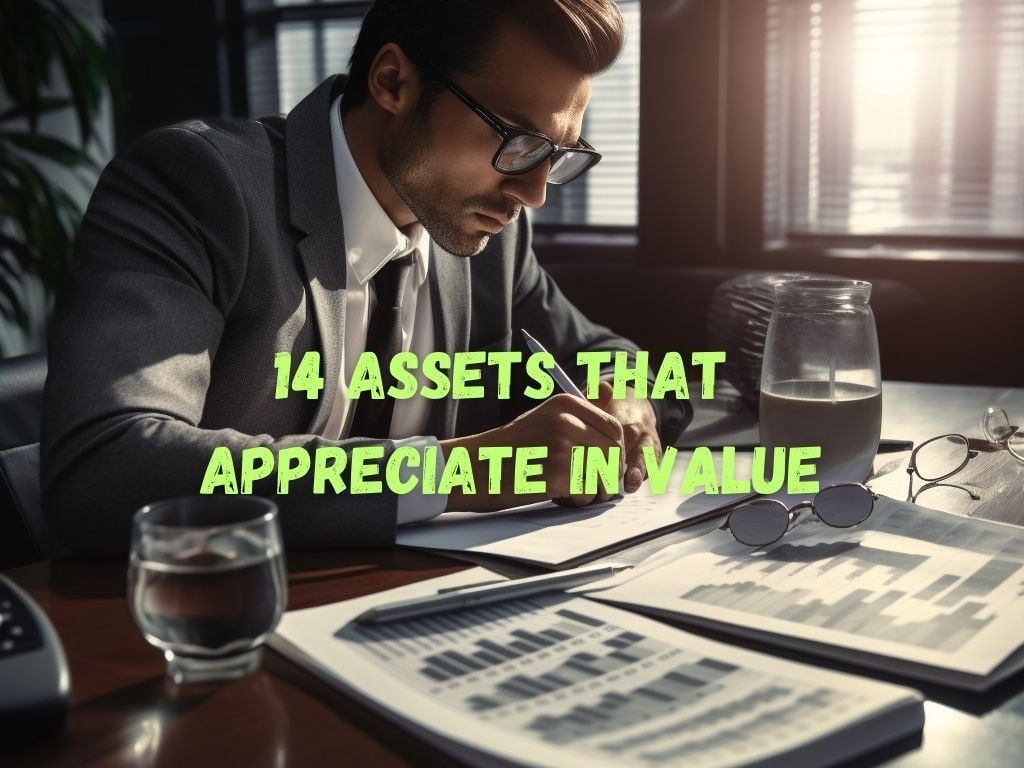Investing in assets that appreciate in value is a key strategy for building long-term wealth.
Unlike assets that depreciate or lose value over time, appreciating assets have the potential to increase in value, providing individuals with a solid return on investment.
That is why many financial advisors suggest you to purchase appreciating assets.
In this article, we will explore various assets that have historically displayed appreciation, their unique characteristics, and pro tips for investing wisely.
4 Popular Assets That Appreciate in Value
Real Estate:
Real estate is one of the most popular assets known for its potential to appreciate over time. Properties in prime locations tend to experience higher appreciation rates due to increased demand and limited supply.
Real estate investing comes in two forms – retail investing and commercial real estate.
Commercial real estate such as malls, offices and hospitals can also provide you significant rental incomes.
This is especially true for properties in areas with robust infrastructure, good schools, and a thriving job market.
Additionally, improvements made to the property can positively impact its value. Investing in real estate for appreciation requires diligent research, understanding market trends, and proper financial planning.
Stocks and Bonds:
Stocks and bonds are another type of asset that can appreciate in value. Stocks represent ownership in a company and their value is influenced by factors such as company performance, earnings growth, and market conditions.
Bonds, on the other hand, are debt instruments issued by governments or corporations and their value can appreciate based on changes in interest rates and credit ratings.
Investing in stocks and bonds requires careful analysis, diversification, and an understanding of the broader economic landscape.
Two other assets linked to stocks and bonds are Exchange Traded Funds and Mutual Funds. Both represent a basket of stocks or bonds traded together.
Lastly, private equity investments are a form of investment where you can buy shares of a firm that is not listed on the stock market. As the company grows, your investment appreciates accordingly.
Art and Collectibles:
Art and collectibles can appreciate significantly over time, making them attractive investment options.
Rarity, historical significance, and the reputation of the artist or creator greatly influence their value.
Artwork, rare coins, stamps, vintage wines, and antique furniture are some examples of appreciating collectibles that can ensure long term financial security for you and your family.
However, investing in art and collectibles requires expertise in the specific field, as it involves assessing authenticity, market demand, and potential risks.

Cryptocurrencies:
Cryptocurrencies, such as Bitcoin and Ethereum, have gained popularity as alternative investments that can appreciate rapidly.
Cryptocurrency prices are influenced by factors like supply and demand dynamics, technological advancements, and wider adoption.
However, it is crucial to be aware of the volatility and regulatory uncertainties associated with cryptocurrencies.
Investing in cryptocurrencies requires thorough research, understanding the technology, and assessing the long-term potential.
10 Unconventional Assets That Appreciate in Value:
Rare Coins and Stamps:
Rare coins and stamps can appreciate in value due to their historical significance, scarcity, and collectors’ demand.
Notable examples include the 1909-S VDB Lincoln cent and the British Guiana 1c Magenta stamp.
Careful research, authentication, and knowledge of the market are crucial for successful investments in this niche segment.
Precious Metals:
Gold, silver, platinum, and other precious metals have a long history of being considered appreciating assets.
Their value is often influenced by currency fluctuations, inflation, and geopolitical factors.
Investors often view them as a hedge against economic uncertainty. It’s important to note that investing in precious metals can be influenced by market sentiment and supply-demand dynamics.
Classic Cars:
Classic cars can appreciate significantly, especially iconic models with limited production numbers and historical importance.
Examples include vintage Ferraris, Porsche 911s, or Ford Mustangs. Factors contributing to their appreciation include their desirability, condition, originality, and documentation.
Classic car investment requires thorough research, knowledge of the automotive market, and understanding collector preferences.
Fine Wines:
Select bottles of fine wines, especially from renowned vineyards, can appreciate in value due to limited supply and increasing demand.
Examples include Château Lafite-Rothschild, Domaine de la Romanée-Conti, and Screaming Eagle.
Expert knowledge of the wine market, storage conditions, vintages, and the ability to identify investment-grade bottles are crucial for successful wine investing.
Farmland:
Farmland has historically shown appreciation due to increasing global population and agricultural productivity. Investing in farmland offers potential long-term returns and diversification benefits.
Factors such as soil quality, location, crop yield, and agricultural practices need to be considered when evaluating investment opportunities in this asset class.

Intellectual Property:
Intellectual property, such as patents, trademarks, and copyrights, can appreciate in value as they generate revenue through licensing and royalties.
Examples include breakthrough inventions, popular song copyrights, and recognized brand trademarks.
Careful evaluation of intellectual property rights, market potential, and legal considerations are essential for this asset class.
Rare Books:
Rare and collectible books, especially first editions or those associated with significant historical events, can appreciate over time.
Examples include classics like Shakespeare’s First Folio or books signed by influential figures like Mark Twain.
In-depth knowledge of the book market, condition assessment, and authenticity verification are necessary for investing in rare books.
Vintage Watches:
Vintage watches from prestigious brands can appreciate substantially due to their craftsmanship, scarcity, and cultural significance.
Iconic models like Rolex Daytona, Omega Speedmaster, or Patek Philippe complications are highly sought after.
Understanding the watch market, brand reputation, condition evaluation, and historical context are crucial for successful investments.
Domain Names:
With the rapid expansion of the internet, premium domain names have become valuable assets.
Memorable and keyword-rich domain names can appreciate in value as businesses seek a recognizable online presence.
Examples of highly valued domains include business.com or insurance.com. However, determining the potential appreciation of a domain name requires thorough research and understanding of current market trends.
Fine Jewelry:
Fine jewelry, featuring exquisite gemstones and craftsmanship, can appreciate over time. Quality, reputation, rarity, and design play a significant role in determining its value.
Examples include jewelry from renowned houses like Cartier, Tiffany & Co., or Harry Winston.
Expertise in gemology, understanding of the jewelry market, and discernment of trends are crucial for investing in fine jewelry.
It’s important to note that each of these assets comes with its own unique considerations, risks, and market dynamics.
Investors should conduct thorough research, seek expert advice when necessary, and diversify their portfolios for optimal risk management and potential returns.

Frequently Asked Questions:
Do all assets appreciate in value?
Not all assets appreciate in value. Some assets, like certain consumer goods or vehicles, tend to depreciate over time. These are called depreciating assets.
How can I determine if an asset will appreciate in value?
Thorough research, analysis of historical trends, and understanding the factors influencing the asset’s value can help determine its appreciation potential.
Is it better to invest in one type of asset or diversify?
Diversification is generally advisable to mitigate risks and optimize returns. Investing in a mix of appreciating assets across different sectors can offer a balanced approach.
How do I know when to sell an appreciating asset?
The decision to sell an appreciating asset depends on various factors, including your financial goals, asset performance, and market conditions. Regular monitoring and periodic reassessment are crucial.
Are there any risks associated with investing in appreciating assets?
Investing in appreciating assets carries certain risks, such as market volatility, changes in demand, regulatory factors, and unforeseen external events. Risk management strategies should be considered.
Conclusion:
Investing in assets that appreciate in value is a wise strategy for long-term wealth creation.
Real estate, stocks and bonds, art and collectibles, cryptocurrencies, and other valuable assets offer diverse opportunities for investors.
Careful research, due diligence, and understanding market trends are essential for successful investments.
By diversifying across different asset classes and exercising patience, individuals can build a portfolio of appreciating assets that will enhance their financial future.


 Tags:
Tags:










